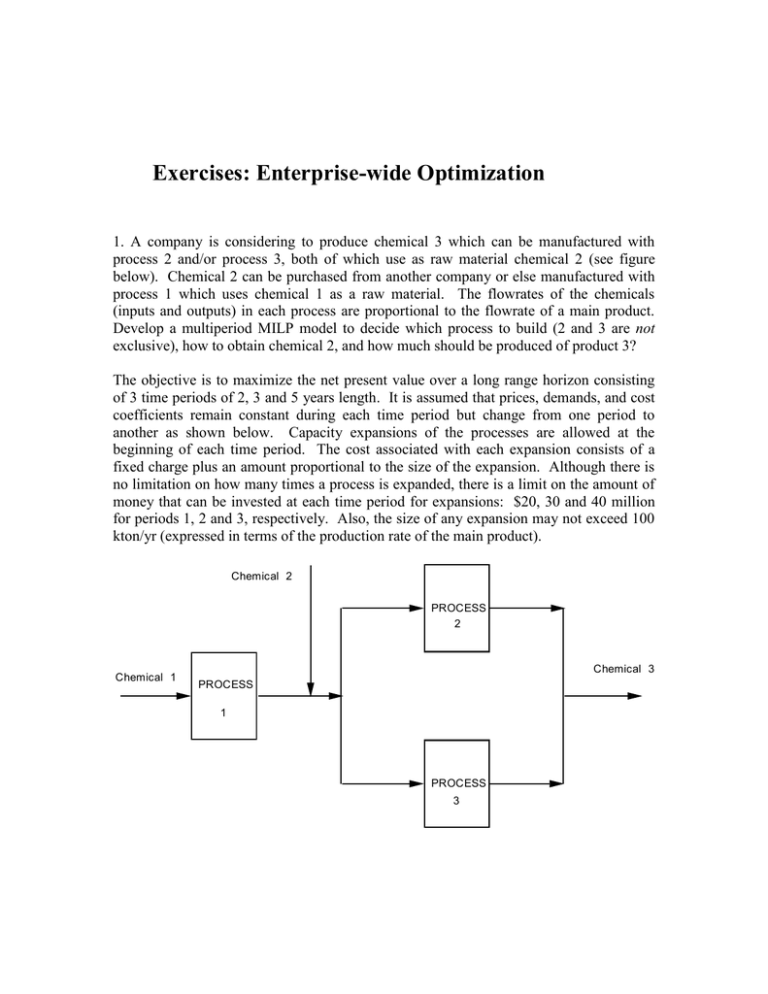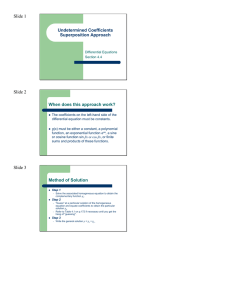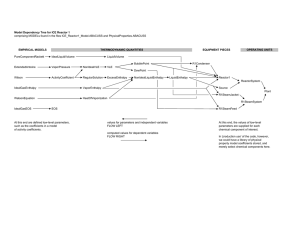Exercises: Enterprise-wide Optimization
advertisement

Exercises: Enterprise-wide Optimization 1. A company is considering to produce chemical 3 which can be manufactured with process 2 and/or process 3, both of which use as raw material chemical 2 (see figure below). Chemical 2 can be purchased from another company or else manufactured with process 1 which uses chemical 1 as a raw material. The flowrates of the chemicals (inputs and outputs) in each process are proportional to the flowrate of a main product. Develop a multiperiod MILP model to decide which process to build (2 and 3 are not exclusive), how to obtain chemical 2, and how much should be produced of product 3? The objective is to maximize the net present value over a long range horizon consisting of 3 time periods of 2, 3 and 5 years length. It is assumed that prices, demands, and cost coefficients remain constant during each time period but change from one period to another as shown below. Capacity expansions of the processes are allowed at the beginning of each time period. The cost associated with each expansion consists of a fixed charge plus an amount proportional to the size of the expansion. Although there is no limitation on how many times a process is expanded, there is a limit on the amount of money that can be invested at each time period for expansions: $20, 30 and 40 million for periods 1, 2 and 3, respectively. Also, the size of any expansion may not exceed 100 kton/yr (expressed in terms of the production rate of the main product). Chemical 2 PROCESS 2 Chemical 1 Chemical 3 PROCESS 1 PROCESS 3 Data: Fixed Investment Coefficients (105 $/ton): Period 1 Period 2 Period 3 Process 1 85 95 Process 2 73 82 Process 3 110 125 112 102 148 Variable Investment Coefficients (102 $/ton): Period 1 Period 2 Period 3 Process 1 1.38 1.56 Process 2 2.72 3.22 Process 3 1.76 2.34 1.78 4.6 2.84 Operating Expenses Coefficients (102 $/ton of main product): Period 1 Period 2 Period 3 Process 1 0.4 0.5 0.6 Process 2 0.6 0.7 0.8 Process 3 0.5 0.6 0.7 Prices (102 $/ton): Period 1 Period 2 Period 3 Chemical 1: 4. 5.24 Chemical 2: 9.6 11.52 Chemical 3: 26.20 29.20 7.32 13.52 35.20 Upper Bounds for Purchases of Raw Materials (kton/yr): Period 1 Period 2 Period 3 Chemical 1: 6. 7.5 8.6 Chemical 2: 20 25.5 30 Upper Bounds for Sales of Products (kton/yr): Period 1 Period 2 Period 3 Chemical 3: 65 75 90 Mass Balance Coefficients (underlined for main products): Chemical 1 Chemical 2 Chemical 3 Process 1: 1.11 1 Process 2: 1.22 1 Process 3: 1.05 1 Miscellaneous Data: Existing Capacity (kton/yr) Process 1 Process 2 Process 3 50 Interest Rate = 10%. Tax Rate = 45%. Depreciation method: straight line. Salvage Value Factor 0.10 0.10 0.10 Working Capital Factor 0.15 0.15 0.15 2. Consider a supply chain consisting of one supplier, three potential DCs and six markets as given in the figure below. Formulate the corresponding MINLP location-inventory model for two cases of the weight factors: a) β = 0.1, θ = 0.01, b) β = 0.01, θ = 0.1. Solve the MINLP with DICOPT, SBB and BARON. Data for supply chain problem Kj Fixed order cost 10 fj Fixed cost to install a DC 100 z Service level parameter 1.96 L Order lead time (days) 7 h Unit inventory holding cost 5 t Days per year 250 Market 1 Market 2 Market 3 Market 4 Market 5 Market 6 Mean demand i Standard Deviation i 948 1570 460 2340 700 1920 140 200 50 200 110 320 Unit transportation cost ( d ij ) between Markets and DCs Market 1 Market 2 Market 3 Market 4 Market 5 Market 6 DC 1 1 2 9 22 38 84 DC 2 50 34 2 2.5 45 57 DC 3 72 33 26 13 3 2 Parameters for shipping of DCs DC 1 DC 2 DC 3 Fixed shipping cost from supplier to DC ( g j ) Unit shipping cost ( a j ) 13 10 14 6 5 7




